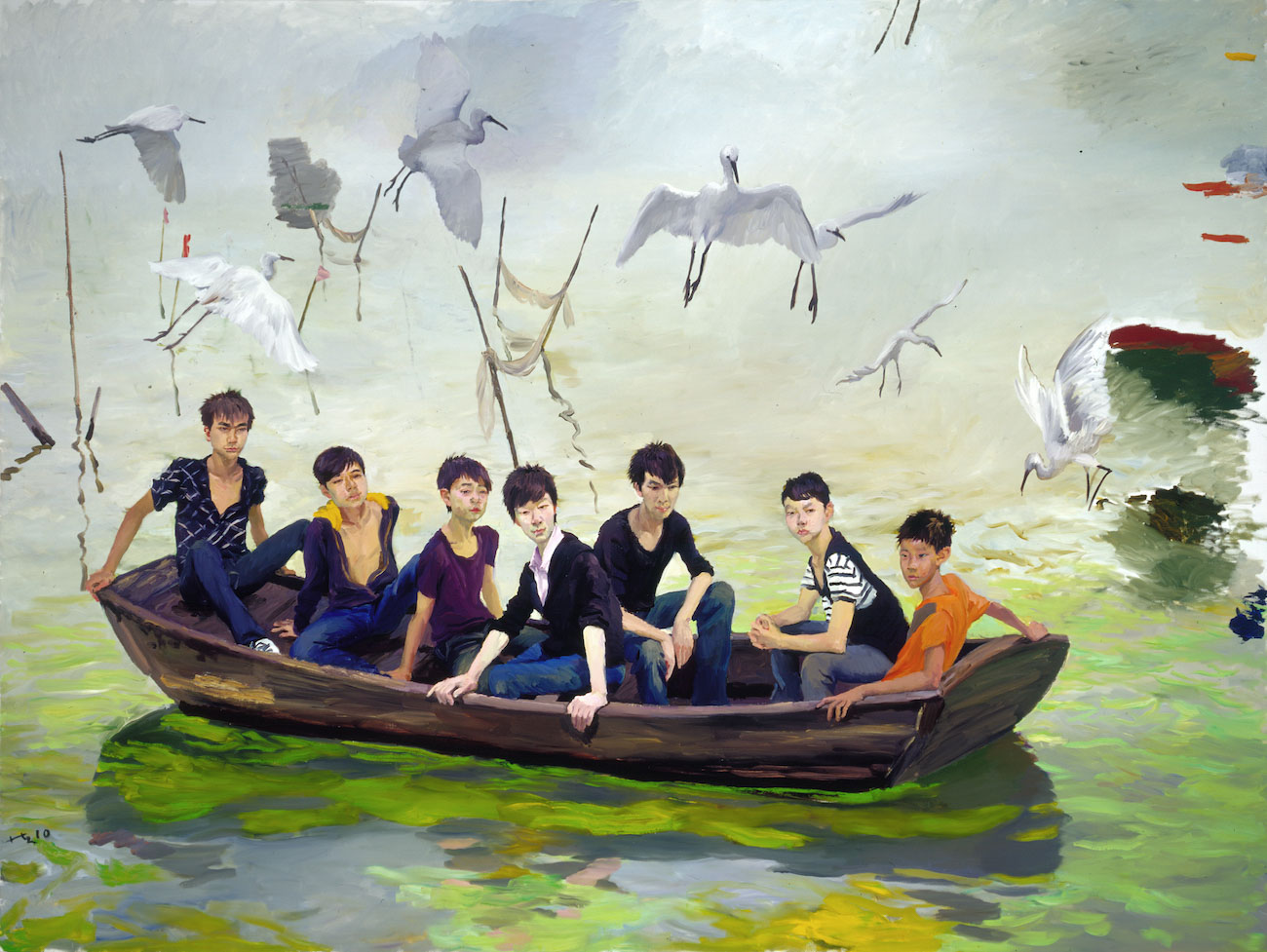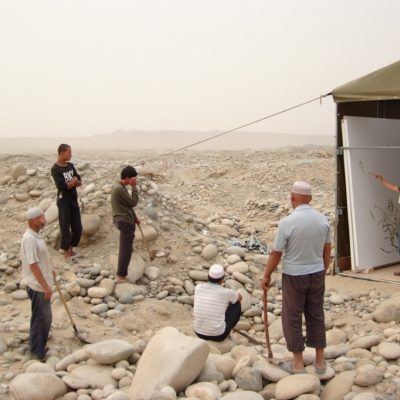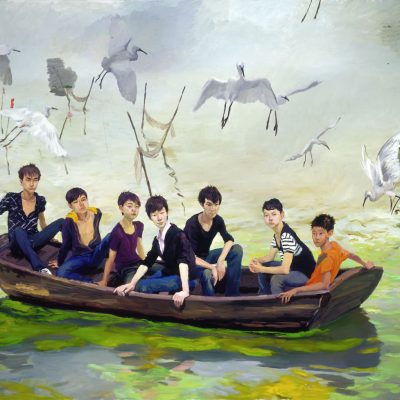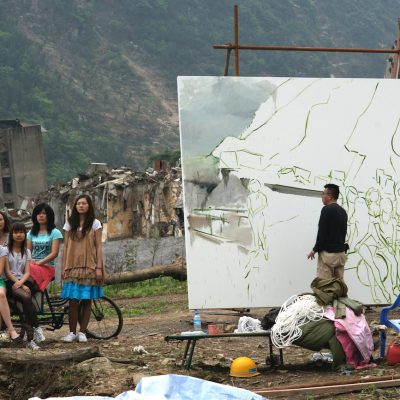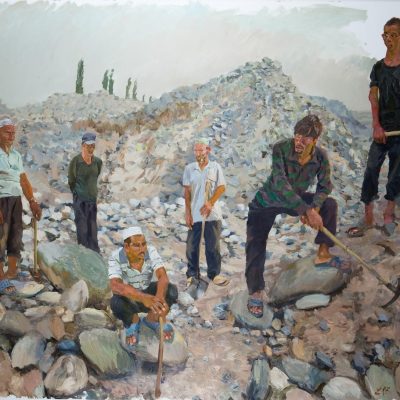Invited to the Lisson gallery, artist Liu Xiaodong and his young prodigy and translator arrive after me, and purposefully settle into chairs around a meetings table in order we can commence our choreographed conversation for print. At first glance Xiaodong appears more academic than artist, with his turtle shaped glasses rolling over his nose, and an inquisitive squint. As I look to his translator for appreciative communications, it all proves a little more subdued than I had anticipated as the artist stays well within himself. Diligently replying and providing answers to a series of questions I pose with reassuring ease. And while Xiaodong and his translator engage in moments of discursive conversation, I almost feel short changed with a dozen words in summary. Which leads to an awkwardness on my part; wanting to know so much more about this accomplished painter of ‘international stature’, (as he has been described), than he is willing to give.
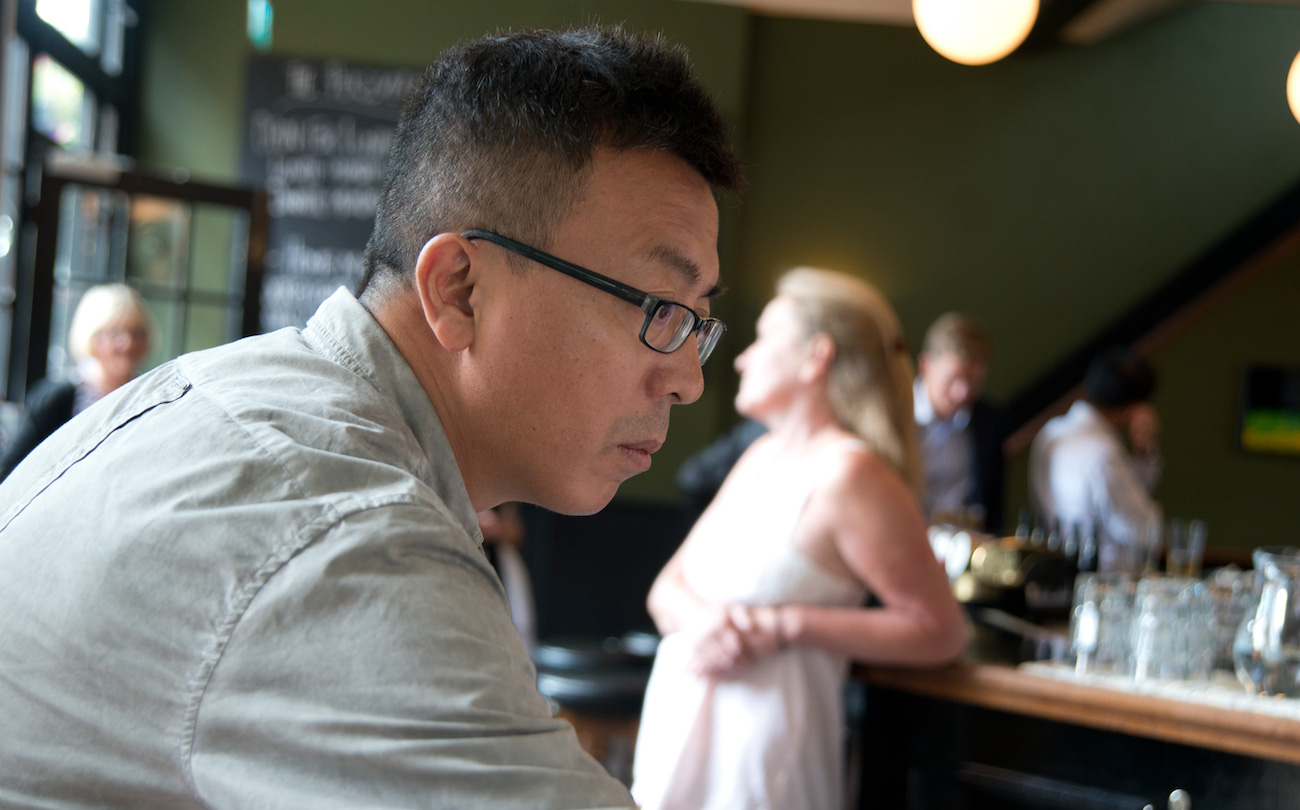
Tellingly it always proves more difficult to interview someone who has already been probed by the press several times already. Between us we agree that for the here and now our translated conversation be all together less difficult, in order we can arrive at something mutually engaging and less exhaustive. In context Xiaodong’s lorded reputation comes as a consequence of his enveloping himself in his individual projects. Having large scale canvases delivered in a truck to a location, where once erect, they are likely to encroach upon his entire field of vision, in order he is able to create vast panoramic paintings that appear as homages to the sites of devastation and damage that he occupies for weeks and months at a time. Xiaodong’s laboured approach has him described as a ‘modern painter of the emerging world’, as he engages very directly with some of the most damning issues of our time. Xiaodong seeks to visually diagnose his subject’s experiences of ‘displacement’, ‘environmental crisis’ and ‘economic upheaval’ in China. And it is as if Xiaodong’s humanitarian methodology proves ever more relevant today, with the sizable shifts of people across the planet. Induced by man-made conflicts and natural disasters alike.
Coined as one of a new breed of ‘neo-realist’ painter, and belonging to a brand of ‘new-realism’ that emerged from the 1990’s in China; Xiaodong has always had great faith in figurative painting capturing the modern experience, as it presents itself. Tellingly in conversation Xiaodong would want it known that he is as much a neo-realist as he is a documentary film-maker, or a diarist. Because for him everything is determined by what he is able to do and the circumstances that allow for that to happen; and much less by linguistic jargon. And what he does when painting these vast panoramic canvases is akin to generating a visual symbol of optimism in the most unlikely of places.
Tellingly Xiaodong’s work proves hugely engaging, as the locations that he is invited to and decides upon, read like recent disaster zones the world over.
Yet unlike the original visionaries of ‘plein air’ painting, (the French impressionists), who sought to capture the elemental atmosphere of a more beautiful moment; as a realist Xiaodong is interested in painting ‘en plein air’ in order to draw attention to more decisive moments of change in places outside of our reach. As the artist’s work visualises the acres of time that proceed that moment, as his people filled landscapes appear to want to sink from beneath his feet. Principally in Xiaodong’s paintings and pencil drawings beauty is reshaped by the ills of cataclysmic catastrophe, as he seeks to capture the visceral unease of people recovering from earthquakes and corrosive pollutants. Initially entering hamlets as a stranger, Xiaodong befriends individuals, shares their daily routine, and determinedly begins to record the lives of the people rooted to these troubled epicentres well after the world has collapsed around them. And unlike the media that arrives and leaves as tourists after a disaster is sufficiently covered for newspaper and television alike; Xiaodong appropriates himself as one of them, in order he can capture something of the upheaval that such ruin brings to bear on people disconnected from the major cities of the extended world. And as a consequence what Xiaodong conceives of is much more ethnographic styled documentation of individual lives; as they are either invited to dutifully sit for him at these points of catastrophe, or otherwise become one of his many new acquaintances that he chooses to indirectly immortalise in one of his make-shift diaries.
Using film, his camera, sketching and scribbling paragraphs of initial information down; Xiaodong employs very playful possibilities as points of entry into the lives of the people reconditioned by their geography. Notably Xiaodong has in the past used film as a medium; working with Wang Xiaoshuai in the highly acclaimed The Days, 1993, and Xiaodong readily refers to major independent films that have been recognised in previous years at the Venice film festival.
Located as he is at the epicentres of both ‘natural’ and ‘man-made’ disasters, Xiaodong begins such substantial projects by employing a procedure and practice that is as practical as it might appear if he were entering a studio to paint a small canvas of a seated figure; though the scale and materials differ greatly. As firstly the size of the canvas and the accompanying crate are considered; measured and constructed in Beijing. Delivered by a large truck to the site, where a make-shift shelter has to be constructed, temporary easels built, containers of oil paints, diaries, drawings delivered, and where reams of photographs and video recording give the project a documentary styled narrative.
As they have all become part of the required apparatus for an artist who will encamp himself on a site for many weeks and months in order to source a complicated diary’s worth of visual information as the beginning of a painting. And once the composition is dutifully decided upon, the project and painting completed; everything is very efficiently deconstructed and packed away for a truck to make the return journey. The canvas is then rehoused into its original wooden crate to be returned to his studio for exhibition.
Xiaodong’s translator describes how “Xiaodong likes to paint a place that has a troubled background, and this kind of background will give him the inspiration to paint.” For Xiaodong his temporary relationships with the inhabitants begin as “strangers in discussion, and then they become good friends, and it is always like this”, in order he can arrive at a work that serves everyone well. And when asked if he ever seeks to return to a location he has earmarked for an artwork, he confirms he will, “if the opportunity presents itself”. Xiaodong is as much preoccupied with new locations and their prevailing circumstances, as he is interested in nostalgia, and his feelings for the familiar. In 2010 Xiaodong returned home to Jincheng, in the north-eastern province of Liaoning. Settling there for over four months, whilst adopting something of his signature ethnographic approach, in order to cultivate the necessary visual and visceral information for a new body of works. Employing a scribbled diary in the first instance, as a method narrative for what he wanted to record and go on to depict.
Xiaodong declares something of a self-interest in what had drawn him back to his place of birth. Saying, “as soon as you begin to talk about your homeland, something starts to happen inside you, something like homesickness. I think in my innermost self, I do not want anything to change in my hometown. You just want your old home to stay as it always used to be. Only if it stays that way can it remain a refuse for us, however much reality is different.” Adding “Urbanisation is spreading much too quickly, destroying everything that we loved or did not love; forming a new city out of everything.” Xiaodong’s scepticism of the indiscriminatory upheaval of modernity goes some way to explain why he is less inclined to engage with any of China’s modern cities, and more interested in the wider agricultural landscape. In Taihu, on the boarder of Jiangsu and Zhejiang provinces in Eastern China, and Beichuan in Central China, as seen through the eyes of its workers and peasant farmers. For Xiaodong then there is much more of China’s history, imbued in people and in the intertwining tapestry of regional provinces, than there is in the industrial cities determined by modern interests.
When asked to divulge something of the strategy for his selecting certain locations over others, having since encamped in cities on sites outside of China. Xiaodong is as reticent to explain what leads him to travel to a new part of the world, as he is to explain the necessity of settling there for such long periods of time. Likened to a peace negotiator on marked earth, the artist absorbs all of the circumstantial evidence as it is laid bare.
Resigned to not knowing, Xiaodong eventually throws anecdotal sound bites my way, before returning to being tight lipped. Explaining that ‘he’ selects his locations, and that he has no predetermined plan for where he will go next; as his pervasive approach to painting translates onto the global stage. For the artist ‘projects’, as he describes them, come one after the other, the specifics of which he is reluctant to explain fully, and the next location outside of China is a tightly guided ‘secret.’ There is a sense then in conversation with Xiaodong, that for the artist the remit for what he does and the manner in which he goes about it, is so incredibly meticulous that he should be allowed to offer very little to a conversation, returning to very simple answers that are like teaspoons of still water, when you feel you deserve a glass. But it still makes for an engaging exchange, in which Xiaodong divulges as much by what he omits from the conversation, as what he carefully chooses to divulge through his more animated translator.
Surprisingly as much as a masterly approach appears to facilitate Xiaodong’s will for making new work; he equally professes to profiting from the ungovernable elements of a project; of which engaging with new communities, eating, drinking, and becoming immersed in their lives, becomes his artistic sustenance and the substance for his work. For the artist when given to considering the properties of location painting, it can be initially about physically building as big a canvas as possible. Discussing scale, he declares an interest in “life-size”; but if the space proves insufficient, he will reduce the scale of the work to fit the revised dimensions. Xiaodong amusingly and very tellingly concludes our time together by saying that when painting, he is little interrupted by any kind of potential audience watching over him paint, because he sees himself “as the tiger scrutinising the rabbit, and able to ignore the trees”.

